Introduction
Sous-vide is a method of heating vacuum-packed meat at a low temperature for a long time. Under sous-vide heating conditions (60°C–65°C), protein-protein interactions and gelatin are minimally transformed in meat; therefore, water retention is improved, enhancing meat tenderness (Tornberg, 2005). In addition, because the meat is heated for a long time, the quality of the outer and inner parts remains constant (García-Linares et al., 2004). Pork sous-vide ham was prepared by curing trimmed pork via immersion in a curing solution and applying low-temperature heat for a long time. As the curing solution penetrates the meat, the trace components in the solution interact with the meat and change its physicochemical state (Yim et al., 2020).
Visual appearances (i.e., color, fat content, shape) are the most important factor that affects consumer food choices. Banović et al. (2009) reported that the intrinsic construct indicates to be reflected better by the color of the meat than by cut and fat. Meat product manufactured with sodium nitrite has a red color, usually a higher consumer preference (Fenger et al., 2015). Myoglobin in meat is converted to metmyoglobin when it comes in contact with oxygen, in this phenomenon, the meat turns brown and loses its original color (red color). Because color is a key deciding factor for consumers when choosing food, preserving the product color throughout its shelf life is important (Kausar et al., 2019; Tomasevic et al., 2021).
In meat products, it has little effect on the pigment denaturation of myoglabin, but low-temperature cooking like a sous-vide can incompletely denature myoglobin and cause a color change (Seyfert et al., 2004). Modified atmosphere packaging (MAP) is used to maintain the appearance, texture, and flavor of meat products by controlling the microflora through a gas composition (James, 2000; McMillin, 2008). Oxygen (O2) combines with myoglobin to form oxymyoglobin to express bright red color (Brody, 2002), or carbon dioxide (CO2) inhibits the growth of microorganisms to prevent color change due to the rancidity of proteins and fats (Farber et al., 2003) in MAP. According to Arvanitoyannis and Stratakos (2012) report, the CIE a* decreased when the oxygen concentration was low, and the TVBN value increased when the CO2 concentration increased to 60% or more. Therefore, it is important to find an appropriate concentration ratio that can increase and maintain CIE a*.
After the bay salt is extracted, most of the remaining seawater is discarded (Voutchkov, 2011). Seawater has a high mineral content and a high potential for use as a food additive (Cipollina et al., 2012). In Korea, processed seawater is sometimes used instead of brine when making tofu and pickled vegetables and is also used to kill unwanted weeds (using microalgae). In addition, in a previous study, when seawater was added to sausages, it could increase CIE a*, similar to nitrite pickling salt (NPS; Lee and Kim, 2020). Therefore, in this study, when MAP with different O2:N2 contents was grafted onto seawater (brine and bitter) as curing agents, 1) whether seawater could fix the meat color even after 3 wk, and 2) the most appropriate concentration to maintain the meat color was analyzed.
Materials and Methods
To prepare sous-vide ham, 24 h post-mortem pork hind legs were purchased from a local market (Yesan, Korea). Gluteus maximus, gluteusmedius, and gluteusminimus were used for the hind limbs, and excess fat and connective tissue were removed. For the cheeks, six lumps were used for each treatment group, for a total of 24 lumps. The four curing agents were classified as follows: control with NaCl (CS), control with NPS (CN), treatment with brine (BR), and treatment with bittern (BT). NPS were prepared by adding 0.006% nitrite to Hanju Salt (Ulsan, Korea). Brine (composition: 5.89% sodium, 2.79% magnesium, 0.80% potassium, 0.03% calcium, etc.) and bittern (composition: 2.80% sodium, 17.90% magnesium chloride, 1.40% potassium, zinc, etc.) were purchased from Yeorumul (Incheon, Korea). The curing agents were prepared by adding 5% salt, 2% sugar, 1% pepper, and 1% spices (fennel 20%, mustard seed 20%, mustard 15%, coriander 15%, black pepper 15%, cloves 10%, bay leaves 4%, red pepper 1%). The 1,000±200 g and the same amount of curing agent were packed in a polyethylene bag to remove as much as possible of the O2. Curing was performed in a refrigerator at 4°C for 5 d. On day 5, the samples were removed from the curing and rinsed. The rinsed samples were vacuum-packed and heated in a water bath at 65°C for 4 h. After heating, the samples were incubated at room temperature for approximately 30 min to remove moisture from the surface.
The cooled sous-vide ham was sliced thinly to aid complete gas absorption and used as the sample. The ham was sliced to a thickness of 2 mm using a food slicer (TI220, Maica, Orlando, FL, USA), and the samples were placed on a plastic tray (QB series, Hypervac, Suwon, Korea) without overlapping. Subsequently, MAP (MAP-H1, Hypervac) was applied using three gas compositions with different O2:N2 ratios of 9:1, 8:2, and 7:3. Samples placed in each gas composition were stored at 4°C for 3 wk and used for the experiments. The 3 wk storage period was determined according to a previous study (DeWitt and Oliveira, 2016).
Physicochemical properties (curing yield, cooking yield, pH, and salinity) were investigated on the same day after heating and cooling to determine whether the curing agent affected the final product. The appearance properties (CIE L*, CIE a*, CIE b*, chroma, hue angle, moisture content, nitrosoheme content, and nitrite residue) of sous-vide ham after 3 wk were analyzed by varying the gas composition ratio.
The curing yield was measured to compare the weight of the cured meat with that of raw meat. The curing agent was applied at a ratio of 1:1 to raw meat for 5 d. The sample was weighed, and the curing yield was calculated using the following formula:
The cooking yield was measured to determine the degree of loss when the cured meat was sous-vide heated, and calculated by measuring the meat weight before and after sous-vide heating at 65°C for 4 h and cooling for 30 min to remove excess moisture. The formula is as follows:
The sous-vide ham was grounded to have the same balance of fat and protein and subsequently used in the pH and salinity tests. After mixing the samples in distilled water at a 1:4 ratio, homogenization was performed using a homogenizer (HMZ-20DN, Poonglim Tech, Seongnam, Korea; 5,654×g). The pH and salinity of the homogenized samples were measured using a pH meter (Model S220, Mettler-Toledo, Schwarzenbach, Switzerland) and a Scionix ssm-1000 (Sxionix SSM, Deagu, Korea).
Color was measured using a colorimeter (CR-10, Minolta, Tokyo, Japan) placed at the center of the ham immediately after removing the wrapping paper from the samples stored for 3 wk in three different gas compositions. After CIE L*, CIE a*, CIE b*, and chroma were measured, the hue angle was calculated using the following formula:
Moisture content was measured using a food scanner (DA 6200, PerkinElmer, Daejeon, Korea) after placing a sample of approximately 150 g on a scanner plate.
The nitrosoheme content was measured using the method described by Kim et al. (2015). Nitrosoheme was extracted by mixing sous-vide ham stored for 3 wk with an acetone/water solution (40:6, v/v) at a ratio of 1:4. The amount of nitrosoheme produced (ppm) was measured at an absorbance of 540 nm using hematin as a standard.
Nitrite residue content was determined according to the method described by Lee and Kim (2020). After homogenizing 10 g of sous-vide ham in 50 mL of distilled water (Ultra Turex, HMZ-20DN), 10 mL of 0.5 M NaOH and 10 mL of 12% zinc sulfate were added, and the mixture was shaken at 80°C. After cooling the sample sufficiently, 20 mL of ammonium acetate was added and the total volume was increased to 200 mL. Next, 1 mL each of sulfanilamide and 1 mL of naphthyl-ethylenediamine were added to 20 mL of the filtered solution, and the final volume was increased to 25 mL using distilled water. A standard curve was measured using a spectrophotometer (SpectraMax iD3, Molecular Devices, San Jose, CA, USA) at 540 nm using nitrite powder (purity: 100%), and the residual amount of nitrite was calculated.
The physicochemical properties were analyzed using one-way analysis of variance and correlation analysis. Traits were evaluated based on treatment types (CS, CN, BR, and BT) as fixed effects. The relationships between the treatment type, gas composition (O2:N2 at ratios of 7:3, 8:2, and 9:1), and color properties were analyzed using two general linear models and correlation analysis. The color traits included the treatment type and gas composition as fixed effects, including their interaction effects. Values are expressed as means±SD, and significant differences between mean values were determined by Duncan’s multiple range test (p<0.05).
Results and Discussion
The quality characteristics of CS, CN, BR, and BT sous-vide pork ham are shown in Table 1. The pH values of BR and BT which used seawater as the curing agent were significantly lower than in the CN and CS which used salt as the curing agent (p<0.05). The pH of the brine and bittern were high for at 8.4 and 8.6, respectively; however, this study result showed contradictory results. Numerous mineral salts and components (e.g., Na+, Mg2+, K+, Ca2+ etc.) exist in seawater; therefore, it is expected that the minerals penetrate into the meat and have a chemical action while going through the curing and heating process. These results indicate that further research is needed on the effect of seawater minerals on meat protein and fat.
BT showed significantly higher salinity than CN (p<0.05). BR had higher salinity than CN, although the difference was not significant. Seawater, which is a balanced mixture that dissolves readily, penetrates meat better than an unbalanced mixture of salt and water. In addition, Majou and Christieans (2018) reported that the lower the pH, the easier the molecules dissociate into protons and anions. Therefore, it is expected that BR and BT, which have a lower pH and are cured with a balanced mixture agent, have a higher salinity. This was consistent with the results of Ruusunen and Puolanne (2005), who concluded that the lower the pH of the meat, the higher the diffusion rate of water molecules and the exchange between the liquid clogged in the pores of the meat and the external liquid. The curing yield was the weight measured after drying the surface moisture by hanging after curing and was used to check the curing performance.
Regarding the curing yield, BT showed a significantly higher value than those of CS and BR (p<0.05), which is possibly due to the high salinity of BT, leading to more even salting of the inside of the meat compared to the other treatments. In addition, curing improves the water retention capacity of muscle tissues because muscle fibers are expanded and salt-soluble proteins are extracted from the meat (Jiang et al., 2019). Accordingly, the cooking yield was also significantly higher in BT than those in the other treatments (p<0.05), which may be because moisture leads to the formation of salt-soluble proteins in meat and salting agents, thereby increasing binding strength. Because a high cooking yield is known to have a positive effect on overall acceptability, it is considered a potential curing agent (Mwove et al., 2018).
The results of the correlation analysis of the physicochemical properties are presented in Table 2. pH showed a significant correlation with salinity, curing and cooking yield (p<0.05). At this same time, salinity and curing yield showed a significantly high correlation (p<0.001). It can be seen that the lower the pH, the higher the salinity. In this study, it was hypothesized that an increase in sodium (Na+) would affect the pH value. Salinity seems to have a significant correlation with curing yield (p<0.001) and curing yield with cooking yield (p<0.001). The addition of salts (N+ and Cl–) to meat increases the ionic strength of meat protein ions, creating space for water binding (Feiner, 2006). The result of the correlation analysis indicated that salinity may be the main variable for sous-vide physicochemical properties. Therefore, it is important that high salinity equalizes the salt content balance of internal and external to enhance processing characteristics (Pinna et al., 2020).
| Variable | pH | SA | CU | CO |
|---|---|---|---|---|
| pH | 1 | 0.78*** | –0.54* | –0.87*** |
| SA | - | 1 | 0.76*** | –0.55* |
| CU | - | - | 1 | 0.77*** |
| CO | - | - | - | 1 |
We believe that the natural curing agent used in this study can have a more positive effect on the processing characteristics of meat than that of salt and brine because it can improve the cooking yield.
Regarding color CIE L*, the CN (8:2), CN (9:1), BR (9:1), and BT (9:1) treatments showed higher values than those of the other treatments (Fig. 1). In addition, the CN (8:2) treatment showed significantly higher values than those of the CN (7:3), CS (7:3), CS (8:2), BR (8:2), and BT (8:2) treatments (p<0.05). Moreover, the gas composition at a 9:1 ratio, which contained the lowest amount of nitrogen, showed a significantly higher value than the gas compositions at 8:2 and 7:3 ratios (p<0.05). Overall, CN treatment with a 9:1 gas composition exhibited high CIE L*. This result indicates that the iron atom (Fe2+) in myoglobin was converted to oxy-myoglobin in the presence of O2 in the packaging. Lu et al. (2020) reported that relatively low oxygen levels can enhance the formation of metmyoglobin because it causes partial conversion in meat. Orkusz et al. (2013) also reported that higher concentrations of O2 were correlated with higher CIE L*, which is similar to the results of the present study.
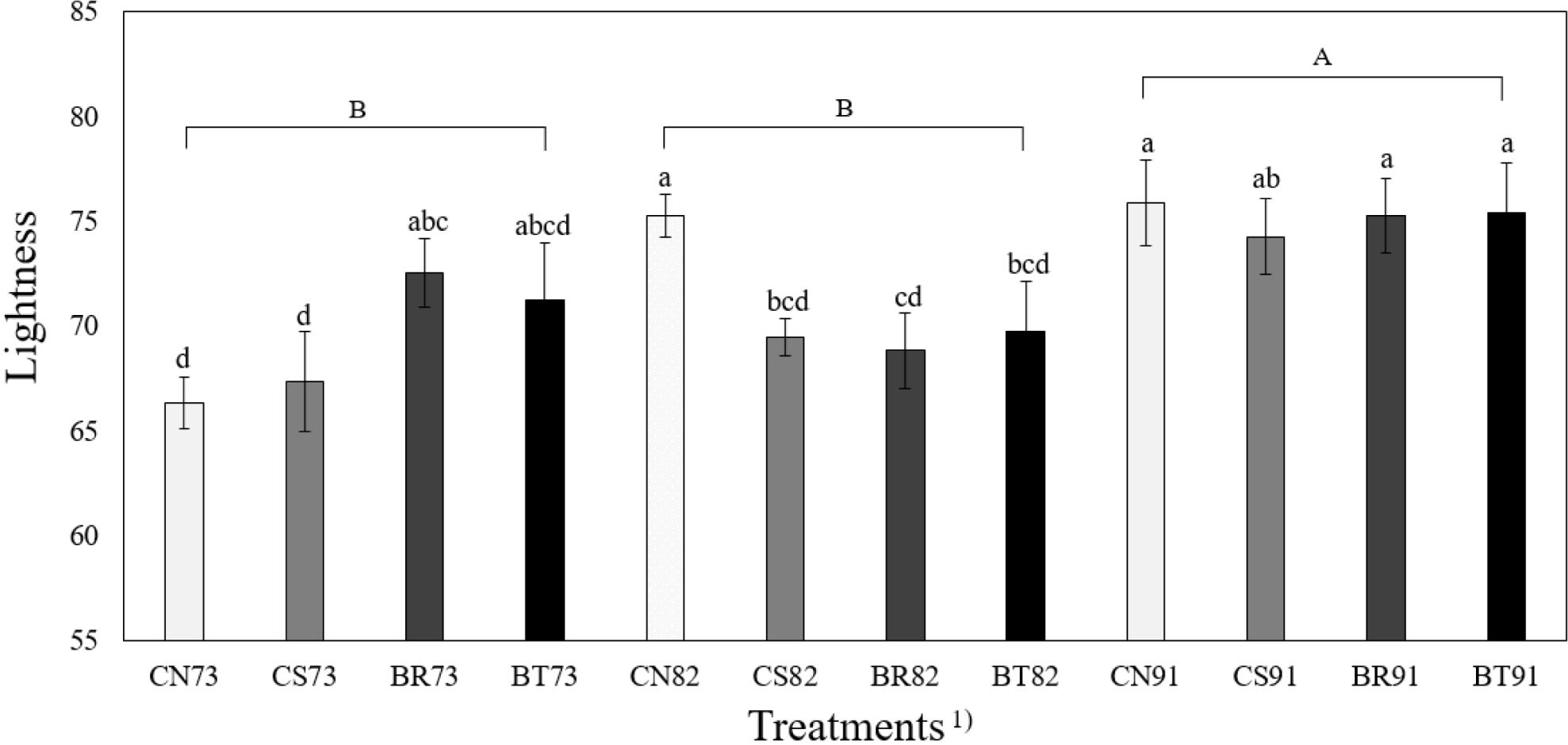
CN (7:3) showed a significantly higher CIE a* than that of the other treatments (p<0.05), followed by BT (7:3). BT (7:3), CN (8:2), CN (9:1), and BT (8:2) showed similar levels, suggesting the possibility of a gas composition in which the BT-curing agent may have a CIE a* similar to that of the treatment group in which NPS was added (Fig. 2). Efforts are being made to replace synthetic color preservatives and preserve the natural CIE a* of meat (Flores and Toldrá, 2021). Between the gas composition treatment groups, more nitrogen (gas composition at a 7:3 ratio) resulted in significantly higher CIE a* than those in more oxygen (gas composition at 8:2 and 9:1 ratios; p<0.05). According to Narasimha Rao and Sachindra (2002), the formation of nitroso-myoglobin in cured meat products increases when the amount of oxygen is limited, this is because high oxygen can brown the product and reduce its CIE L*, reducing CIE a*. Therefore, a lower oxygen content (not too high) helps maintain the pink color.
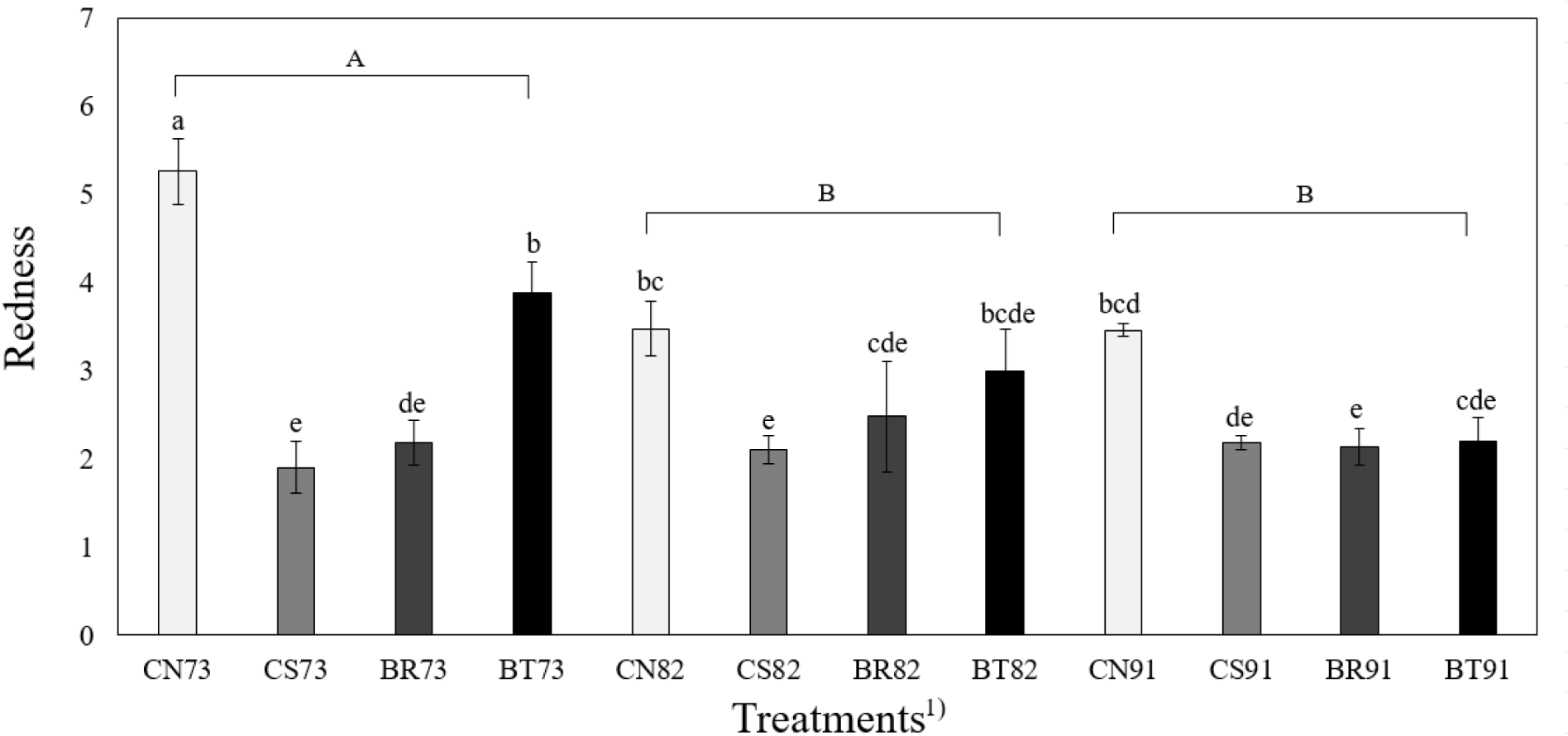
CN (8:2) had the highest CIE b* and CN (7:3) had the lowest value. The 7:3 gas composition, which contained a large amount of nitrogen, showed a significantly lower CIE b* than the other treatment groups, which seemed to decrease as the CIE a* increased (Fig. 3). Wang et al. (2021) reported that meat CIE b* increased, and CIE a* and CIE L* decreased due to microbial spoilage, myoglobin autoxidation, and lipid oxidation during the retail period. In the present study, CIE a* decreased and CIE b* increased with an increase in the storage period (data not shown). The color was brighter in the gas composition 8:2 group than in the gas composition 7:3 group (p<0.05). CN (8:2), BT (7:3 and 8:2), and BR (8:2 and 9:1) showed similar chroma values (Fig. 4). According to Tapp et al. (2011), chroma is expressed as color saturation or vividness; the higher the value, the clearer the color. Because CIE b* and chroma showed similar tendencies, saturation seemed to be more affected by CIE b* than by CIE a*.
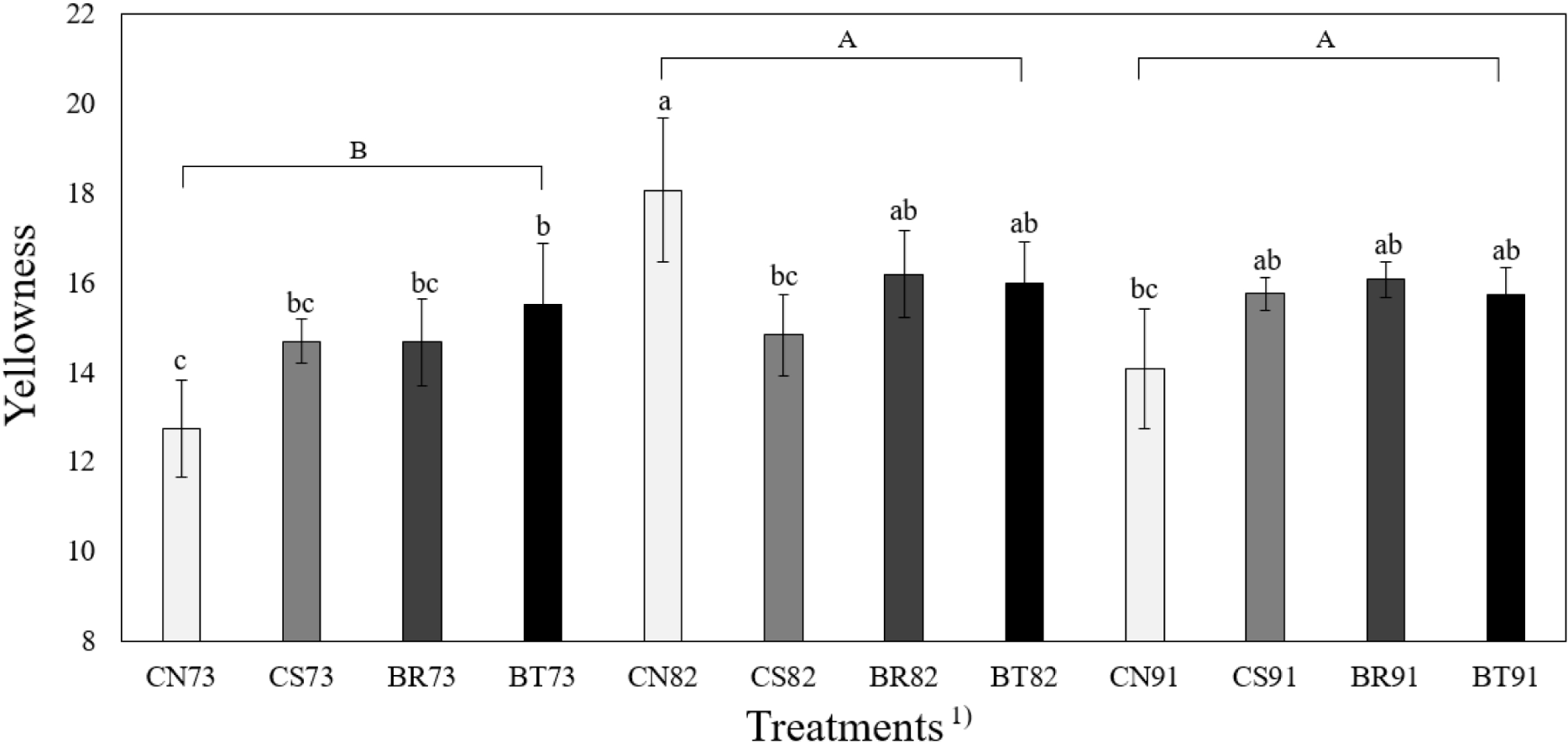
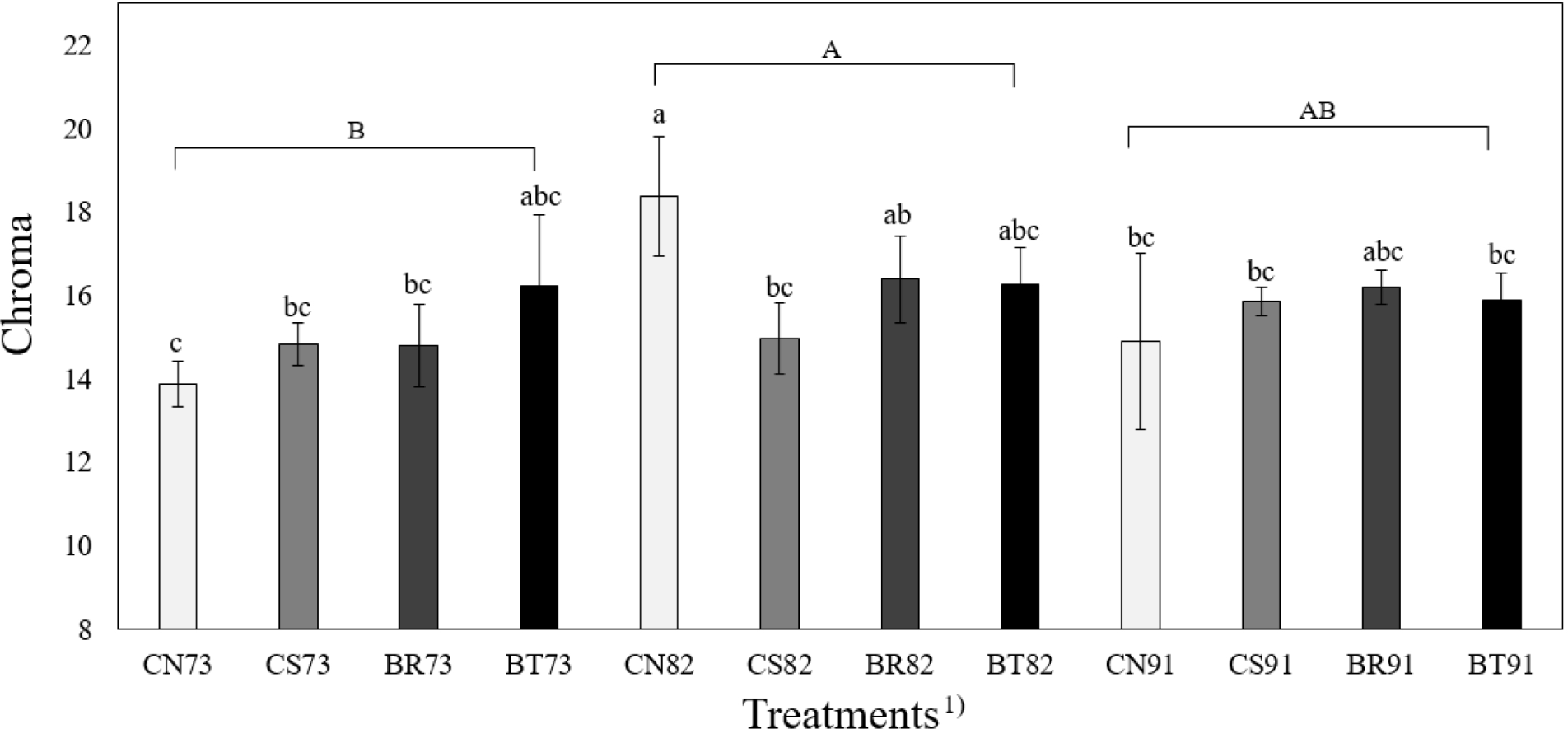
The hue angle of the gas composition 7:3 group was significantly lower than that of the 8:2 and 9:1 gas composition groups (p<0.05). The CS and BR groups showed significantly higher values than the other treatment groups for all gas compositions [p<0.05, excluding BT (9:1)]. BT (7:3) showed a value similar to that of CN (8:2), implying that sous-vide ham packed at 7:3 and 8:2 gas compositions with bittern and NPS as curing agents, respectively, had the same color (Fig. 5). This result indicates that for a hue angle, a certain color in the range of 0°–360° is designated as 0°, 90°, 180°, and 270°, representing red, yellow, green, and blue hues, respectively (Pathare et al., 2013). Therefore, CS (8:2), BR (8:2), and BR (9:1) had high CIE b* and similar values compared to the other treatments, whereas BT (7:3) and CN (8:2) had relatively red colors and similar values. The high hue angle can be interpreted in two ways: oxidation of oxymyoglobin and reduction of nitrosyl hemochrome (da Conceição Jorge et al., 2015; Haile et al., 2013). Therefore, we expected that BT (7:3) and CN (8:2) would have a higher nitrosyl hemochrome content or lower oxidation of meat than CS (8:2) and BR (8:2 and 9:1).
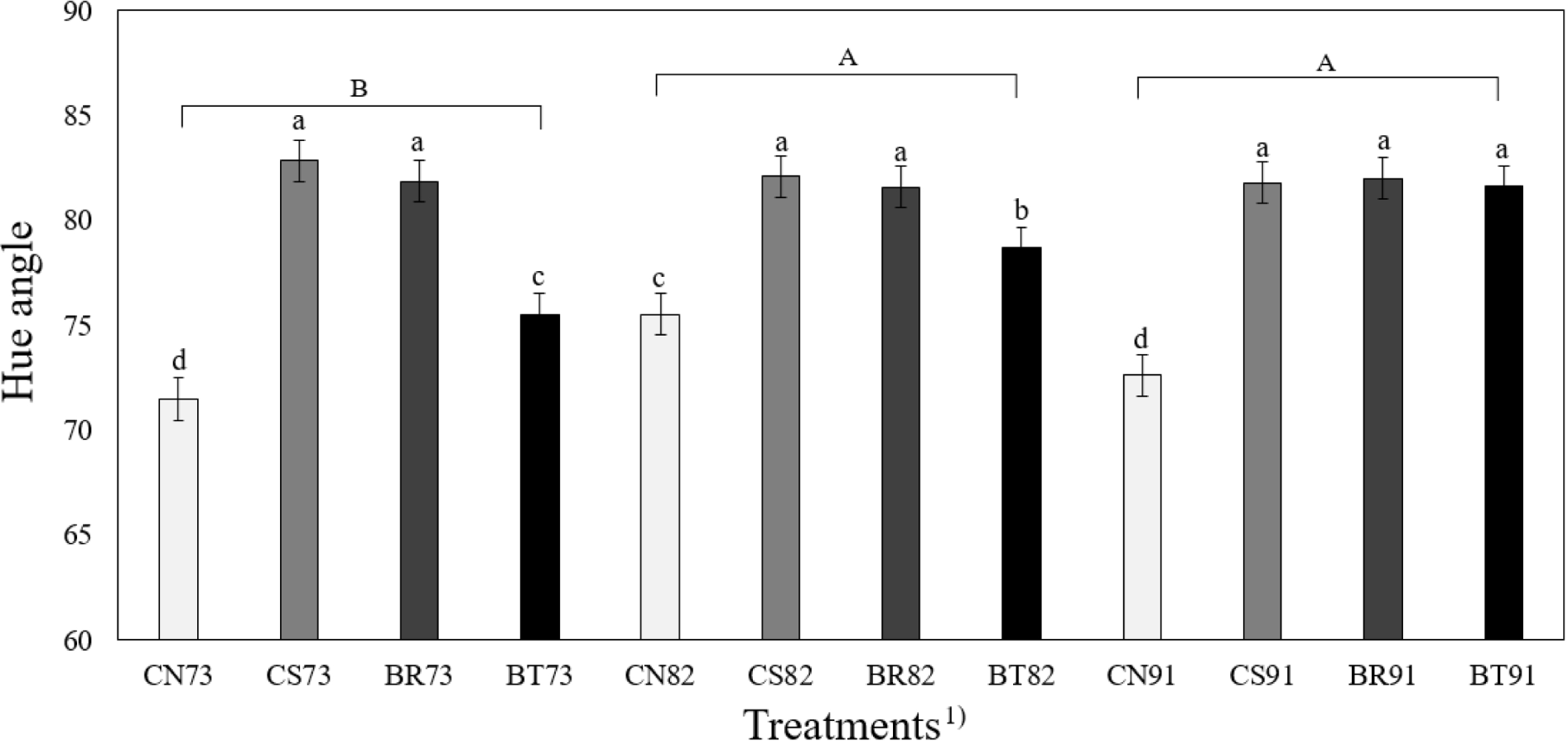
The moisture content was highest for BR (9:1) and lowest for BT (9:1) (Fig. 6). Qiao et al. (2001) showed that the moisture content was negatively correlated with CIE a* and positively correlated with CIE b*. Compared to the hue angle in this study, the moisture content of BR with high CIE b* was high, and the fact that BT had high CIE a* owing to low moisture was similar. In contrast, the gas compositions at 7:3 and 9:1 ratios showed significantly higher values than those at an 8:2 ratio (p<0.05); however, the cause was not identified. We believe that moisture content did not affect the gas composition ratio in this study.
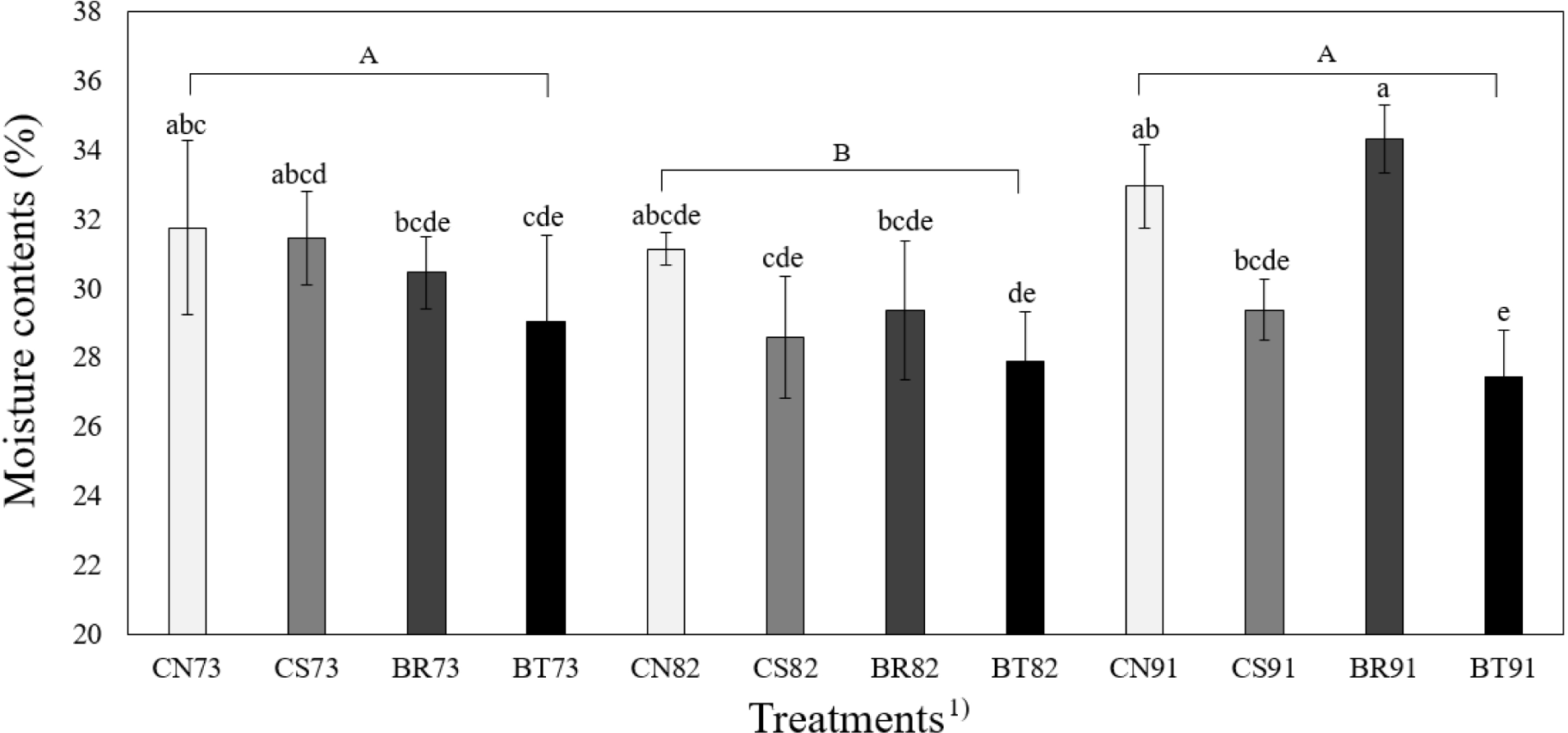
The nitrosoheme content was significantly higher in the nitrogen-rich packaging (p<0.05). In addition, sous-vide ham (CN) with NPS showed high values at gas compositions of 7:3 and 8:2, and the CS treatment showed the highest value after CN treatment (Fig. 7). The residual amount of nitrite also showed that CN had a significantly higher value than the other treatments for all gas compositions (p<0.05). In the case of the CN treatment, the residual amount of nitrite was lowered when the nitrogen-to-oxygen ratio was 3:7 (Fig. 8). The nitrogen-rich gas composition helps maintain the adhesion of nitric oxide (NO) to heme iron in meat. Skibsted (2011) reported that NO affects the color stability of processed meat products and food storage safety.
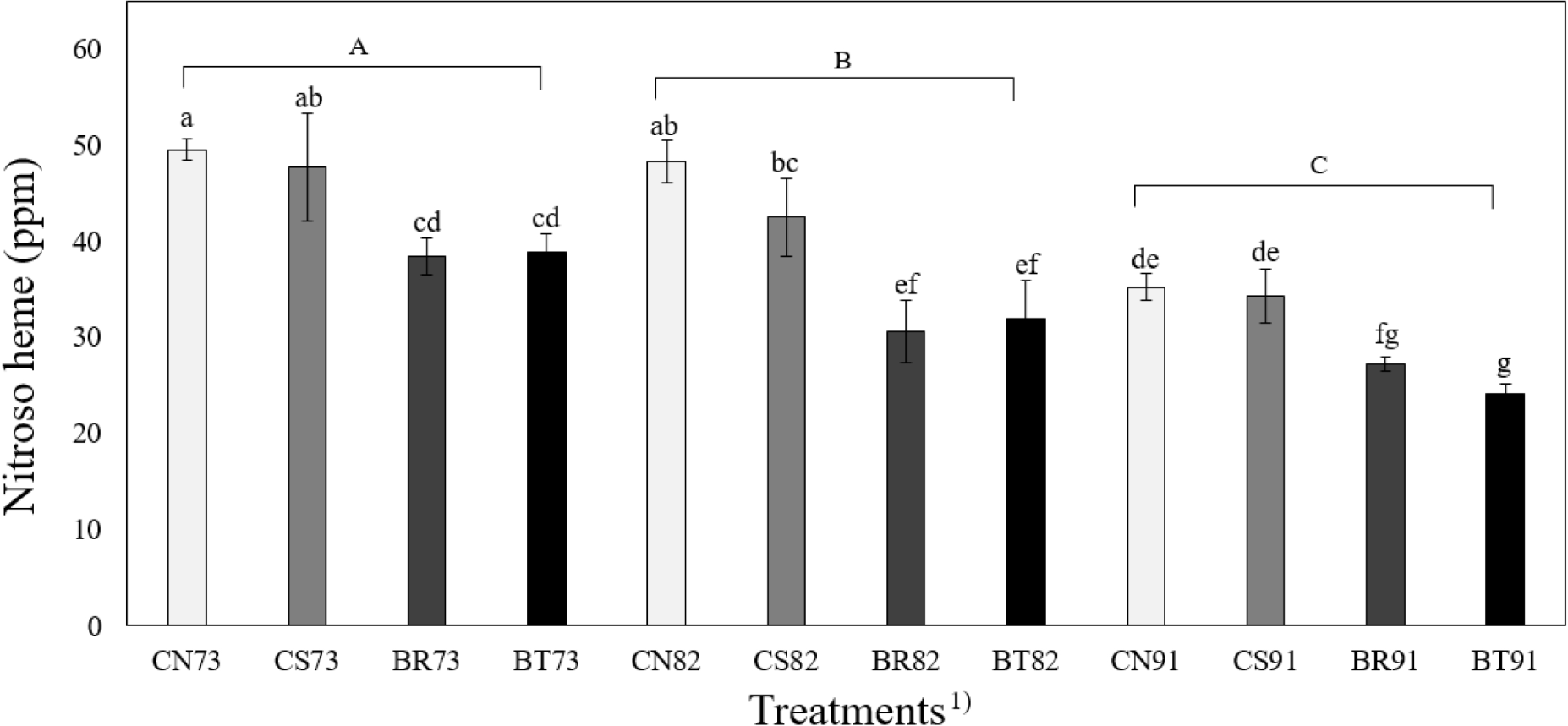
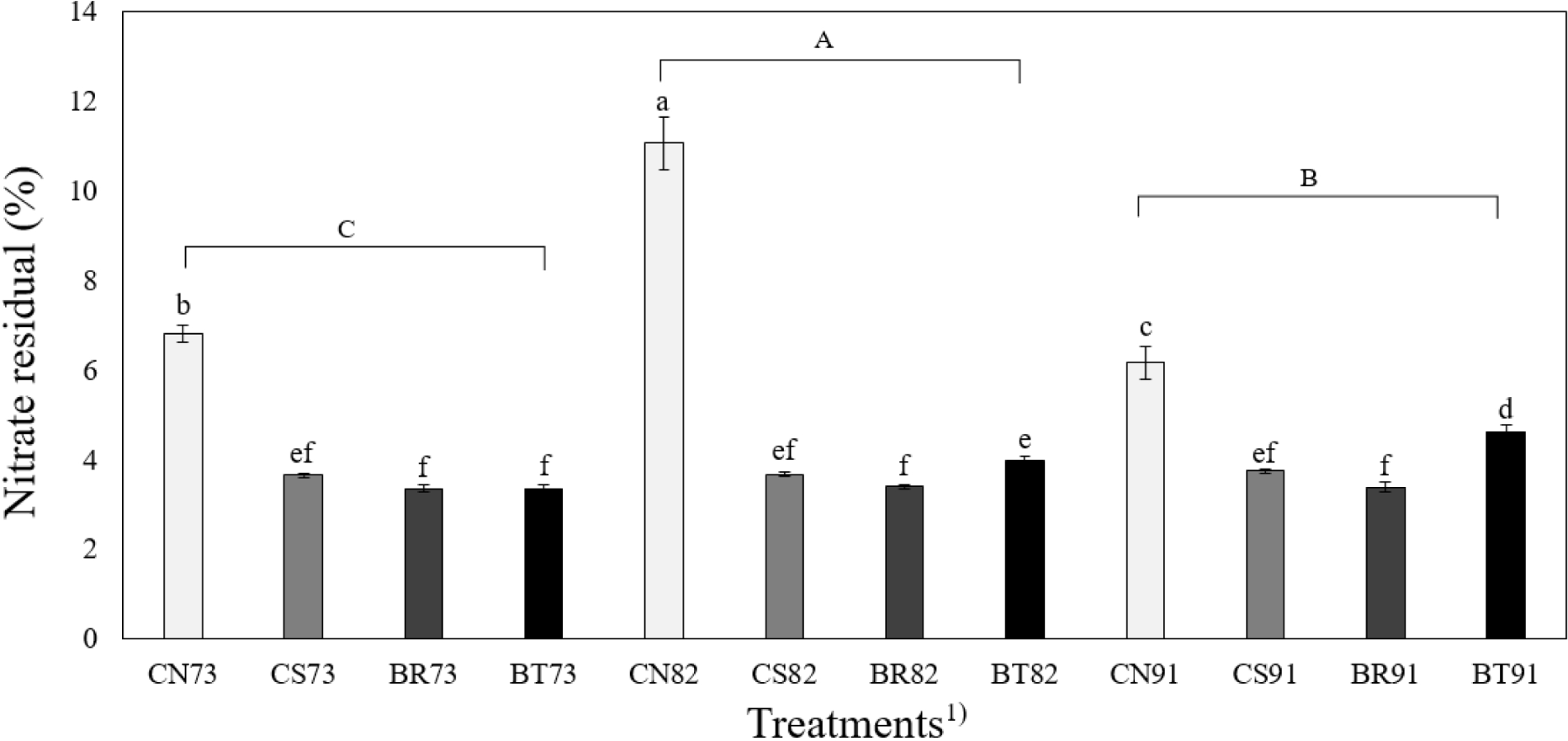
When the curing agent was analyzed, the NPS-treated CN and bittern seawater-treated BT were similar. BT had a significantly lower residual nitrite value than CN; however, both samples had a similar color appearance in terms of CIE a* and hue angle. Therefore, BT has a high potential as a natural curing agent. When analyzed together with the gas composition, CN (7:3) and BT (8:2) showed similar results.
CIE L* was positively correlated with hue value and moisture content (p<0.001) and negatively correlated with CIE b* (p<0.01), chroma, and nitrosoheme content (p<0.05). CIE a* was positively correlated with moisture and nitrosoheme levels (p<0.001), and negatively correlated with hue value, residual nitrite level (p<0.01), and chroma (p<0.05). CIE b* was positively correlated with nitrosoheme and residual nitrite levels (p<0.001), and negatively correlated with moisture (p<0.01) and hue value (p<0.05). Chroma positively correlated with residual nitrite levels (p<0.001) and negatively correlated with nitrosoheme (p<0.01) and moisture levels (p<0.05). The hue value negatively correlated with the residual nitrite level (p<0.01) and nitrosoheme content (p<0.05; Table 3).
The higher the oxygen concentration in the packaging gas, the higher the CIE L* and hue angle; the higher the nitrogen concentration, the higher the CIE a*, thereby appealing to consumer preferences (Pereira and Malfeito-Ferreira, 2015). In contrast, because the hue angle increased as the value changed from CIE a* to CIE b*, the lower the value of the hue angle, the higher the CIE a*. Highly energetic NO gas represents nitrosomyoglobin, which exhibits strong stability by reacting with the Fe2+ of myoglobin (Wang et al., 2018). However, when nitrite/nitrate, a synthetic color preservative, is added and a high nitrogen gas composition is maintained, a high residual amount of nitrite is displayed, which can cause nitrosamine when consuming food (Jannat et al., 2014). Therefore, manufacturing meat products using seawater as a curing agent is possible, similar to those treated with NPS, by adjusting the moisture content and hue angle by altering the nitrogen concentration after reducing or removing the synthetic color preservative.
Conclusion
This study aimed to analyze whether seawater, as a natural curing agent, can have a positive effect on the appearance of sous-vide ham without affecting its quality characteristics. In addition, it is to analyze the gas composition that can maintain the meat color during the storage period. In terms of physicochemical properties, BT showed superior processing properties compared with the control group (CS). The seawater-treated group exhibited improved curing and cooking yields. Consequently, BT is considered to have better quality characteristics than CN and CS under equal conditions.
In terms of color properties, the CIE a* of CN (8:2), CN (9:1), BT (7:3), and BT (8:2) showed similar values. In the same gas composition, BT is judged to have a possibility to replace the synthetic compound (NPS) because it shows a lower amount of nitrite residue and nitrosoheme than CN. Moreover, the hue angles of the BT (7:3) and CN (8:2) groups were similar. Thus, sous-vide ham cured with BT and NPS and packed with gas compositions at 7:3 and 8:2 ratios showed similar colors.
Therefore, our results indicated that seawater can replace synthetic color preservatives by improving the physicochemical properties and preserving CIE a*. In addition, our study confirmed that the best possibility was to set the O2:N2 gas composition to 7:3 for bittered seawater sous-vide ham.













